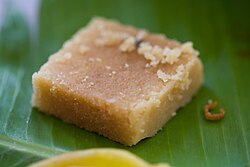History
It is prepared and given at weddings and other festivals, including baby showers, in southern India.
The Maharaja of Mysore, Krishna Raja Wadiyar IV, was a food lover and maintained a large kitchen at the Amba Vilas Palace in Mysore. [4]
Kakasura Madappa, the head chef known for preparing sweets, began experimenting, wanting to present the King with something unusual. Adding gram flour, ghee and sugar, he made a soft paaka (or mixture). Madappa was called in and asked for its name. He said the first thing that came to his mind - 'Mysore Pak'. The Maharaja loved the sweet so much that he asked Madappa to open a sweet shop outside the premises of the palace. [5]
Paaka or extreme sweet refers to the sticky sugar syrup obtained by simmering sugar with an equal amount of water; specifically for Mysore pak, the simple syrup heated to the softball stage. The syrup is used as the primary sweetening agent in various Indian sweet dishes like Jalebi, Gulab Jamun, Badam puri, Mysore pak and others. The syrup is given taste with spice essences like cardamom, rose, honey etc. Paaka syrup preparation is a skilled art mastered by only a few cooks, some of whom keep their methods secret.
The recipe improved through the years. However, the original sweet made with the original recipe is still available at the famous "Guru Sweets" stores in Devaraja Market, run by Kumar and Shivanand, great-grandsons of Madappa. [6]
This page is based on this
Wikipedia article Text is available under the
CC BY-SA 4.0 license; additional terms may apply.
Images, videos and audio are available under their respective licenses.

